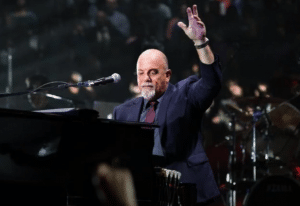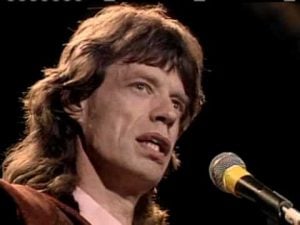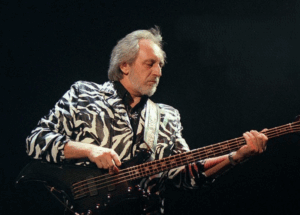10 Classic Rock Songs From The 60s That Still Give Us Goosebumps

via TopBackingTracks / YouTube
Rock music underwent a revolutionary transformation in the 1960s, a decade characterized by the genre’s daring and inventiveness. Rock reached its adulthood at this time, defined by the unique sound of the amplified electric guitar, which allowed the music to explore new avenues for musical expression. Young people were enthralled by it, and their parents were unable to suppress their confusion. The songs of this decade cemented their place in history by igniting a musical and cultural movement. These eight songs from the 1960s never fail to chill listeners and inspire appreciation for their avant-garde brilliance.
10. JUMPIN’ JACK FLASH – Rolling Stones (1968)
The Rolling Stones’ “Jumpin’ Jack Flash” is a brilliant example of their dynamic energy. They are renowned for their energetic concerts and their ability to convey the spirit of rock ‘n’ roll. With its catchy guitar riff by Keith Richards, the song shot to fame for its unadulterated intensity and defiant attitude. Mick Jagger said that this song was a turning point for the band, coming out of a phase of creative experimenting to get back to their rock roots. Brian Jones agreed, saying that the track’s foundation in the group’s original sound was important.
The song “Jumpin’ Jack Flash” became an absolute classic in rock music thanks to its catchy tempo and unforgettable lyrics. Its composition, which was motivated by Richards’ gardener Jack and the term “Jumpin’ Jack,” demonstrates the band’s ability to transform ordinary experiences into timeless music. The song’s success lies not only in its chart position but also in its ability to evoke the unwavering spirit of the late ’60s and leave a lasting impression on rock music.
9. WHITE RABBIT – Jefferson Airplane (1967)
Grace Slick’s “White Rabbit,” with its complex story adapted from Alice in Wonderland, presents a menacing indictment of how society views kids and the subtle allusions to drug use that are found in such innocent stories. The song’s captivating crescendo, which showcases Slick’s remarkable songwriting and vocal prowess, takes listeners on a fascinating journey. Partly inspired by the arrangement of Ravel’s “Bolero,” the music replicates the slow build-up of the classical composition, producing an equally hypnotic effect within the psychedelic rock genre.
In Jefferson Airplane’s discography, “White Rabbit” is a standout track that perfectly captures the counterculture movement of the 1960s. The song’s innovative musical arrangement and thought-provoking lyrics made it stand the test of time, captivating listeners for many years. The song’s dramatic ending phrase, which exhorts listeners to “feed your head,” perfectly captures the song’s defiance of social standards and conventional wisdom.
8. MY GENERATION – The Who (1965)
The Who’s “My Generation” captured the angst and hopes of a generation trying to set itself apart from its forebears and became an anthem for the young rebellion of the 1960s. The angry tone of the song and Roger Daltrey’s stammering vocal perfectly capture youth’s frustration and impatience. It may not have reached the top of the American charts, but it had an enormous influence on culture and music, paving the way for punk rock’s unadulterated, unrefined energy to emerge in the next decade.
The song’s well-known line, “Hope I die before I get old,” became a catchphrase for the movement that embodied the desire to rebel against social standards and a spirit of change. “My Generation” expressed a generation’s sense of identity and established The Who as a powerful force in rock music. It is still a potent representation of adolescent rebellion and the pursuit of authenticity.
7. WHOLE LOTTA LOVE – Led Zeppelin (1969)
From the first notes of “Whole Lotta Love,” listeners are introduced to Led Zeppelin’s bold and innovative sound. The song, featured on their second album, showcases a fusion of blues-rock with hard-hitting lyrics and groundbreaking production. Led Zeppelin’s approach to this track, featuring Jimmy Page’s iconic guitar riff and Robert Plant’s impassioned vocals, set a new standard for rock music, blending technical skill with raw emotional power.
The song’s middle section, with its avant-garde use of studio effects, exemplifies the band’s willingness to experiment and push musical boundaries. “Whole Lotta Love” not only became one of Led Zeppelin’s most famous tracks but also a foundational piece of the hard rock genre. It illustrates the band’s ability to captivate audiences with their musical prowess and daring creativity.
6. I PUT A SPELL ON YOU – Creedence Clearwater Revival (1968)
Creedence Clearwater Revival’s rendition of “I Put a Spell On You” is a compelling showcase of the band’s ability to reinterpret existing songs with their unique sound. Their version of this Screamin’ Jay Hawkins classic is filled with emotion, from the haunting guitar intro to John Fogerty’s powerful vocal delivery. The track’s intensity is heightened by the tight instrumentation and dynamic arrangements, making it a standout in CCR’s catalogue.
The song encapsulates the band’s mastery of blending rock with elements of the blues, creating music that feels both timeless and deeply rooted in American tradition. Creedence Clearwater Revival’s version of “I Put a Spell On You” is celebrated for its emotional depth and the raw energy that the band brings to every note, securing its place as a memorable and influential cover.
5. CROSSROADS (Live at Winterland) – Cream (1968)
Cream’s live version of “Crossroads,” recorded at Winterland Ballroom, is heralded as one of the greatest live performances in rock history. This rendition of the Robert Johnson blues standard is electrified by Eric Clapton’s masterful guitar solos, supported by the cohesive rhythm section of Jack Bruce on bass and Ginger Baker on drums. Their collective performance breathes new life into the song, transforming it into a high-energy rock anthem that showcases the trio’s technical skill and musical chemistry.
The significance of Cream’s “Crossroads” lies not only in its technical brilliance but also in its ability to capture the essence of the blues while propelling it into the realm of rock. The track stands as a testament to the band’s influence in bridging genres and influencing countless musicians. Their interpretation remains a landmark recording, demonstrating the enduring power and emotional depth of the blues when filtered through the lens of rock music.
4. (I CAN’T GET NO) SATISFACTION – Rolling Stones (1965)
The Rolling Stones’ “(I Can’t Get No) Satisfaction” is an enduring anthem of disillusionment and desire, marked by its iconic opening guitar riff. This track, which delves into themes of commercialism and the elusive nature of fulfillment, struck a chord with audiences worldwide, becoming a defining moment in the band’s career. Despite its controversial lyrics and the initial hesitation of radio stations to play the song, it quickly rose to the top of the charts, cementing its place in rock history.
The song’s success is attributed not only to its catchy melody and lyrical relevance but also to the Rolling Stones’ ability to encapsulate the zeitgeist of the mid-1960s. “(I Can’t Get No) Satisfaction” showcases the band’s talent for blending rock’s raw energy with incisive social commentary, making it a powerful and relatable anthem that continues to resonate with listeners.
3. ALL ALONG THE WATCHTOWER – Jimi Hendrix Experience (1968)
Jimi Hendrix’s take of Bob Dylan’s “All Along the Watchtower” is a brilliant retelling that showcases Hendrix’s extraordinary guitar prowess and creative approach to songwriting. Through creative arrangements and a ground-breaking guitar solo—which Dylan himself has commended for its impact and creativity—his version elevates the original. Hendrix’s mastery is on display as he turns the folk ballad into a potent rock song, solidifying this rendition as one of his most cherished performances.
“All Along the Watchtower” is a perfect example of Hendrix’s ability to reinvent songs and give them a fresh perspective. In addition to honoring Dylan’s poetic skill, his rendition affirms the guitar’s essential role as an expressive instrument in rock music. This song continues to stand as a testament to Hendrix’s legacy and his singular influence on the development of rock music.
2. GIMME SHELTER – Rolling Stones (1969)
“Gimme Shelter” captures the Rolling Stones at their creative zenith, delivering a song that is both a plea for peace and a reflection on the tumultuous era it was born from. The song’s haunting opening, characterized by the evocative guitar work of Keith Richards, sets a somber tone for this exploration of seeking refuge amidst chaos. The inclusion of Merry Clayton’s powerful backing vocals adds a layer of urgency and emotion, making the song even more impactful.
Written during one of the most volatile periods in modern history, “Gimme Shelter” resonates with the fears and hopes of its time, yet its message of seeking solace in the face of adversity is timeless. The Stones’ ability to marry raw emotion with masterful musicianship results in a track that is not just a musical achievement but also a profound commentary on the human condition.
1. LIGHT MY FIRE (Extended Version) – The Doors (1967)
While opinions may vary on whether “Light My Fire” is the pinnacle of ’60s rock, the seven-minute album version of this seminal track by The Doors is undeniably a rock masterpiece. This extended rendition, which is not just my personal favorite from the decade but also ranks second among my all-time beloved songs (just behind “Stairway to Heaven”), showcases an innovative musical composition. The song’s allure largely stems from Ray Manzarek’s expert manipulation of the Vox Continental organ, producing the captivating and persistent signature sound that defines the entire track. Complementing this is session musician Larry Knechtel’s contribution on the Fender Precision Bass guitar, which adeptly doubles the keyboard bass line. Robby Krieger, the song’s composer, offers an enthralling guitar solo during the instrumental break, while Jim Morrison’s deeply seductive and potent vocals elevate the piece to a mesmerizing level. Through its perfect synergy of instrumental prowess and vocal intensity, “Light My Fire” firmly holds its ground as an extraordinary creation in rock history.





























